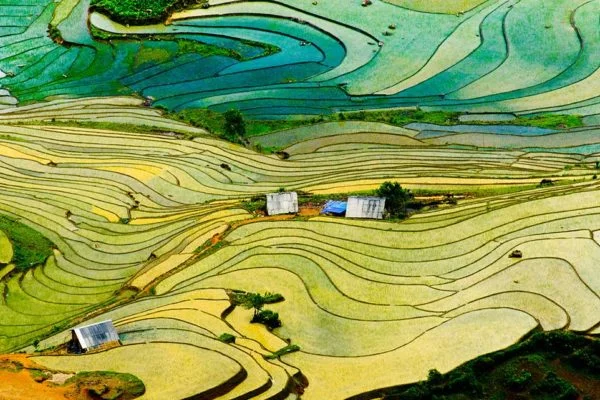The Best 12 Traditional Products In Vietnam That You Should Bring Home
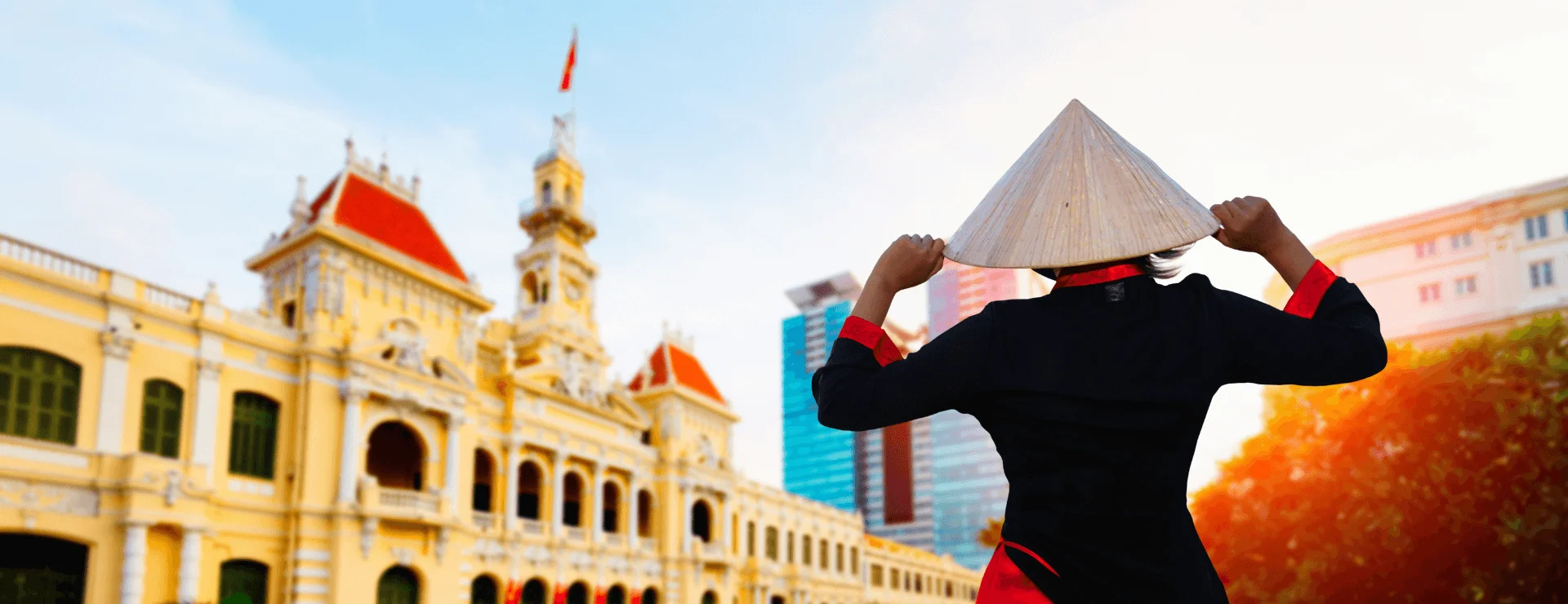
Vietnam is a country known for its rich cultural diversity and breathtaking landscapes. With a complex history and hundreds of artisan villages to explore, it offers a unique experience. However, selecting traditional products in Vietnam as gifts can be a challenge. To help you, Asia Pioneer Travel has compiled a list of the top 12 Vietnamese souvenirs that will delight your loved ones and serve as a wonderful reminder of your trip.
Souvenir Guide: Traditional Products in Vietnam to Bring Home
Non La (Conical Hat): Vietnam’s Timeless Cultural Symbol
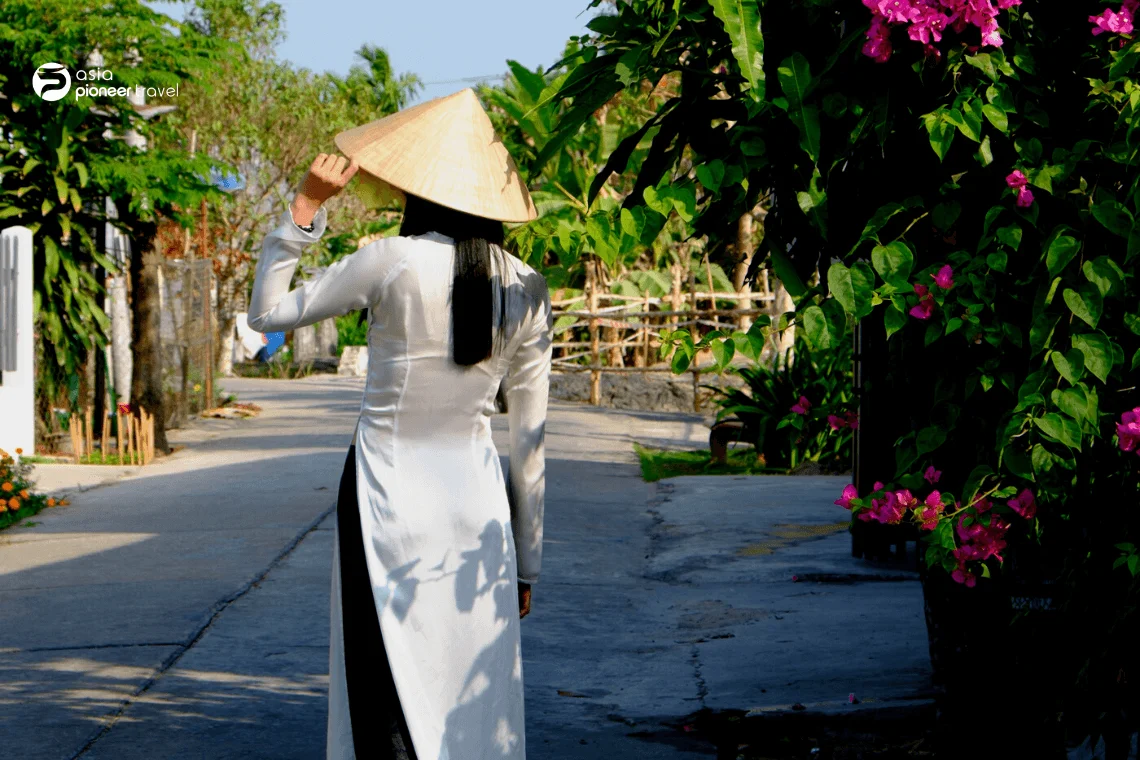
The Non La (conical hat) ranks among Vietnam’s most iconic symbols, cherished as both a practical tool and a cultural treasure. This handcrafted headwear has roots dating back over 3,000 years, with early depictions found on ancient bronze drums from the Dong Son culture (circa 1000 BCE). Traditionally worn by women, it remains integral to Vietnamese identity, though it is now used by all genders in rural settings for sun and rain protection.
Key Details
- Materials: Made from natural leaves (often palm or bamboo) woven over bamboo frames, reflecting resilience to tropical climates.
- Cultural Significance:
- Featured in legends about a goddess who saved villagers from storms by using her oversized hat as shelter.
- The Ao Dai is depicted alongside as a cornerstone of traditional attire, symbolizing femininity and heritage.
- Usage: While less common in urban areas, it is still worn by farmers, market vendors, and travelers seeking protection outdoors.
Purchasing Tips
You can acquire a Non La at:
- Souvenir shops: Prices range from 30,000–100,000 VND ($1.30–$4.30 USD).
- Local markets: Expect competitive rates (as low as 20,000 VND/$1 USD).
Note: Prices may vary based on craftsmanship and location.
Ao Dai: Vietnam’s Iconic Traditional Dress

The Ao Dai (long tunic) is Vietnam’s most treasured national garment, symbolizing grace, femininity, and cultural heritage. Its design typically features long sleeves, a high, mandarin-style collar, and side slits that extend to the waist, paired with loose-fitting pants. While traditionally worn by women, modern adaptations occasionally include men’s designs.
Usage and Style
- Cultural Occasions: Worn nationwide for weddings, Tet (Lunar New Year), and formal events.
- Colors and Fabrics: Options range from silk and satin to cotton. Red garments signify prosperity (common at weddings), while white denotes purity (often for school uniforms). Lotus and dragon motifs may be added for cultural symbolism.
Custom Tailoring Experience
Creating a bespoke Ao Dai in Vietnam is a popular choice, with prices starting at 600,000 VND ($25 USD) for basic silk sets, depending on fabric quality and customization. Hoi An is renowned for its rapid tailoring services, often delivering orders within 24–48 hours.
>> Read More: Top Unmissable Things to Do in Hoi An
Vietnamese Coffee: A Brewing Legacy
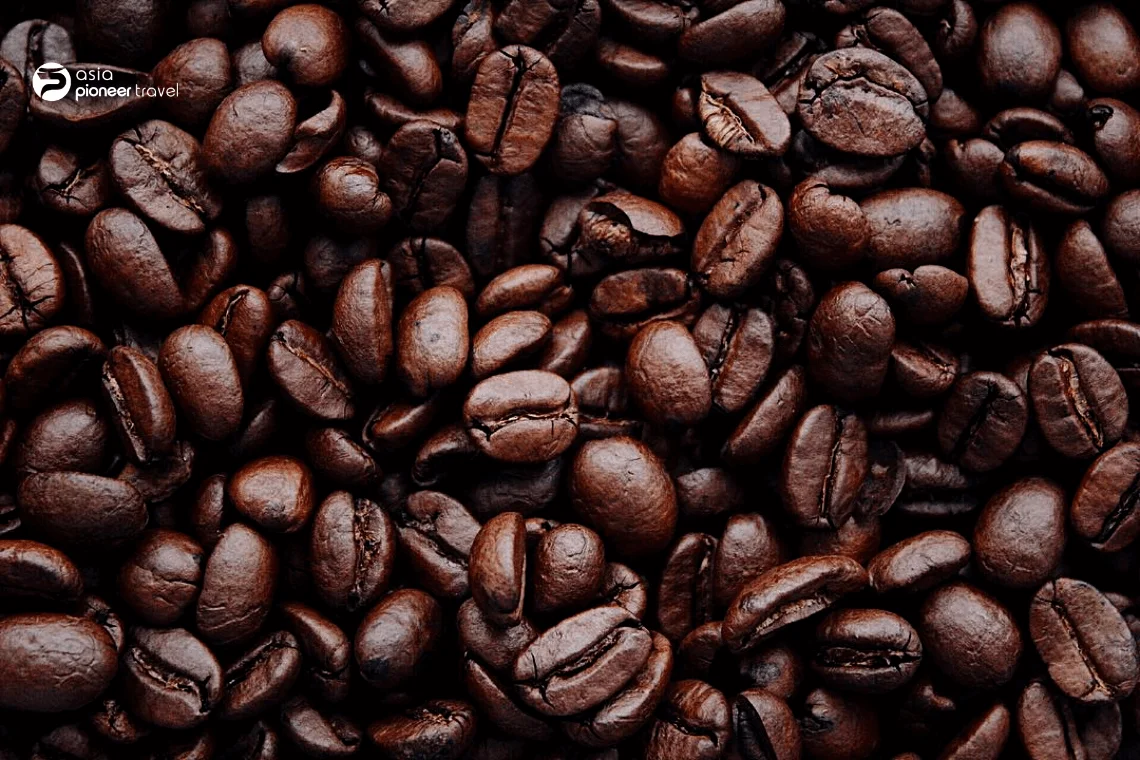
Vietnam stands as the second-largest coffee exporter and the world’s top producer of Robusta beans, with a thriving industry that blends tradition, quality, and innovation. Its coffee culture—including beloved beverages like Ca phe den da (black iced coffee), Ca phe sua da (coffee with condensed milk over ice), Ca phe trung (egg coffee), and Ca phe sua chua (yogurt coffee)—reflects its rich agricultural heritage and creativity.
Key Facts
Production Hub
- Focus on the Central Highlands (Buon Ma Thuot, Da Lat, Pleiku), which accounts for 92% of national coffee output.
- Ideal climate and volcanic soil drive high yields, with 31 million 60-kg bags forecast for 2025/26 (predominantly Robusta).
Market Dynamics
- Exports: Reached $4.7 billion in early 2025, driven by strong demand in the EU, US, and emerging markets like Algeria and Mexico.
- Quality Range: Coffee beans typically cost 170,000–600,000 VND ($7–$25 USD) per kilogram, depending on brand and grade.
Cultural Significance
Domestic consumption is rising, projected to hit 4.9 million bags in 2025/26, fueled by café culture and urbanization.
Pro Tips For Coffee Souvenirs
- Phin filter: Essential for authentic Vietnamese coffee preparation, available from 25,000 VND ($1.07 USD) at local markets or airports.
- Source Regions: Visit Buon Ma Thuot or Da Lat for premium beans directly from farms.
>> Read More: Best 5 Vietnam Destinations For Coffee Lovers
Silk Products: A Lunar Tapestry of Tradition and Craft
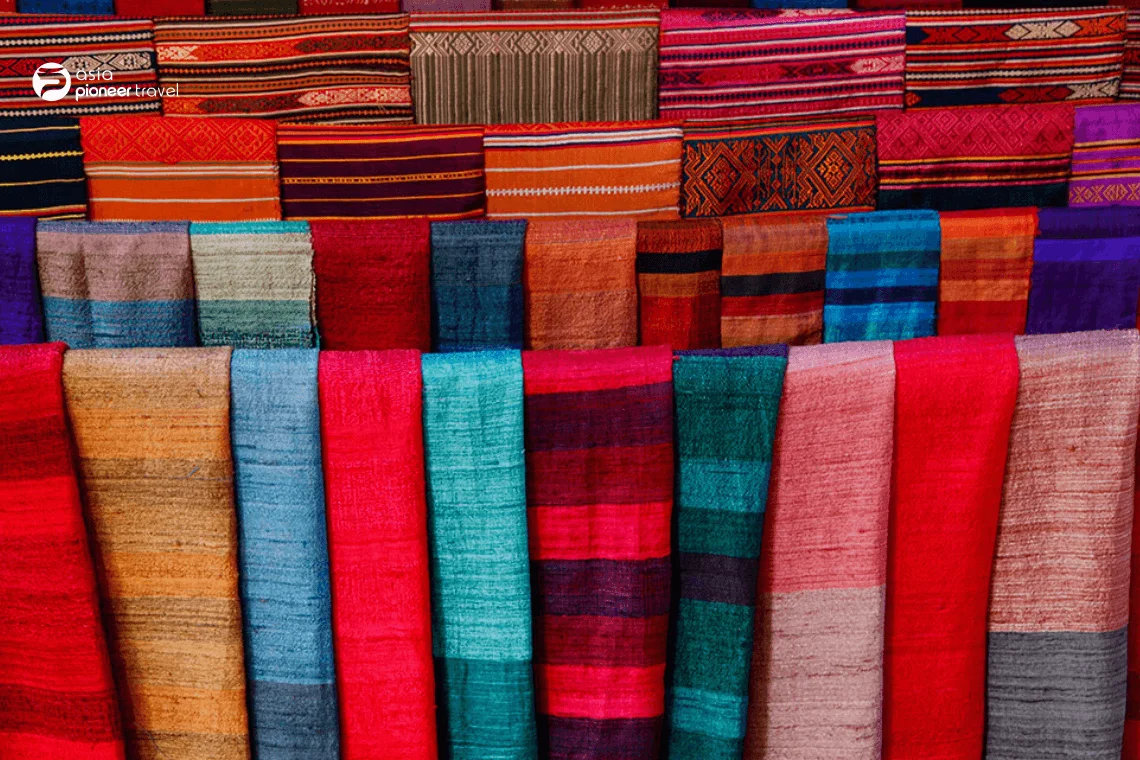
Silk remains a quintessential Vietnamese souvenir, prized for its natural softness, durability, and vibrant designs. From bustling markets in Hanoi’s Old Quarter to artisan villages in Hoi An, silk products are readily available in a spectrum of colors and patterns.
Silk Villages and Specialty Regions
- Van Phuc (Hanoi): Renowned since the 15th century for mulberry-woven silk, featuring a signature sheen.
- Tan Chau (Mekong Delta): Famous for naturally dyed black silk and innovative color palettes using local fruits and plants.
- Bao Loc (Lam Dong): Accounts for 80% of Vietnam’s silk production, though much of its output consists of raw fabric.
Product Variety
- Common Items: Silk scarves, garments (including custom Ao Dai), home textiles, and accessories (bags, shawls).
- Customization: Tailor shops in Hoi An, such as D Duy Xuyen Village, offer bespoke pieces using traditional looms and modern techniques.
Pricing and Quality
- Fabric Costs: Roughly 230,000 VND ($10 USD) per meter for basic silk, with premium options (e.g., hand-dyed Tan Chau silk) priced higher.
- Authenticity Tips: Avoid synthetic blends by checking for natural sheen, smooth texture, and colorfastness (proper dyeing methods leave minimal residue in water).
Vietnamese Musical Instruments: Echoes of Ethnic Diversity
Vietnam’s 54 ethnic groups have crafted a symphony of musical traditions, often using natural materials like wood, bamboo, and metal to reflect their environments and lifestyles. These instruments are not only pivotal to cultural rituals but also popular souvenirs for travelers.
String Instruments
- Dan Tranh (16-String Zither): Made of wood and horsehair strings, this “princess of Vietnamese instruments” is central to classical and folk music (e.g., Tuong theatre).
- Dan Bau (Monochord Zither): Features a gourd resonator and bamboo stick for tone modulation, producing ethereal sounds in folk and ceremonial contexts.
- Dan Nhi (Two-Stringed Fiddle): A simple wooden body with metal strings, used widely in Cheo and Quan Ho performances.
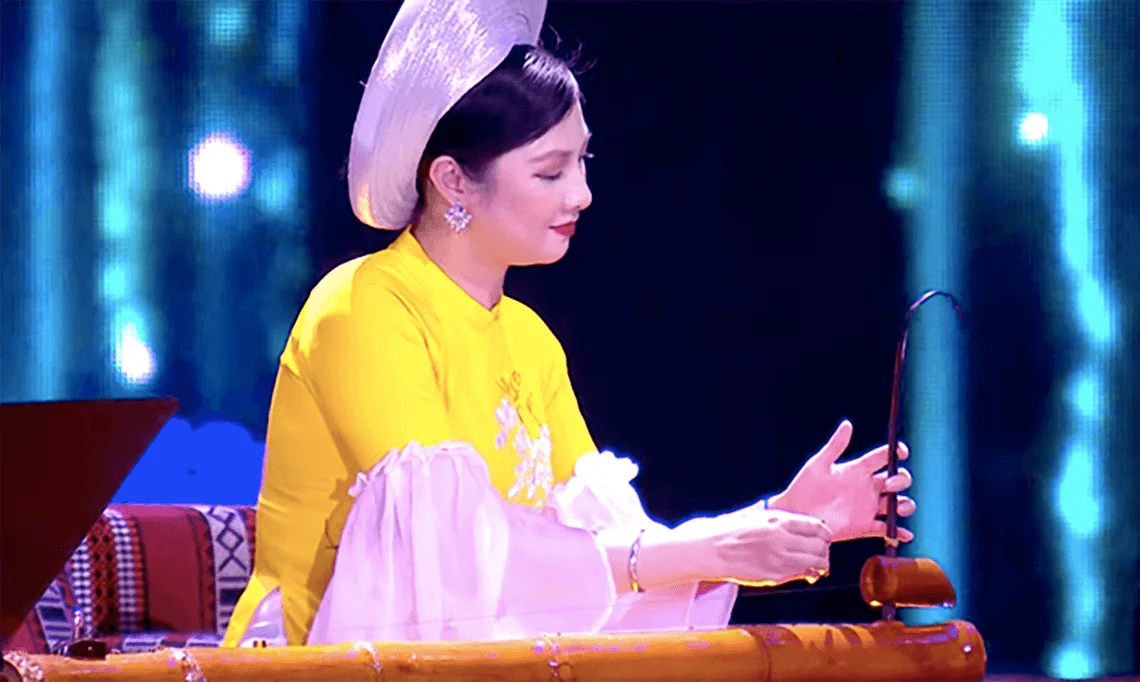
The traditional Dan Bau (Monochord Zither)
Wind Instruments
- Sao Truc (Bamboo Flute): Mimics natural sounds (e.g., streams) and accompanies folk songs.
- Ken Bau (Trumpet): A double-reed oboe made of wood/metal, used in Nha Nhac (court music) and ethnic ceremonies.
Percussion & Others
Drums: Often crafted from wood and animal skin, they are used in festivals and communal dances.
Souvenir Tips
- Portable Options: Favor miniature flutes, small drums, or simplified zithers to ease luggage constraints.
- Materials to Note: Prioritize handcrafted instruments to avoid synthetic plastics or mass-produced replicas.
Guoc Moc (Wooden Clogs): Timeless Vietnamese Footwear
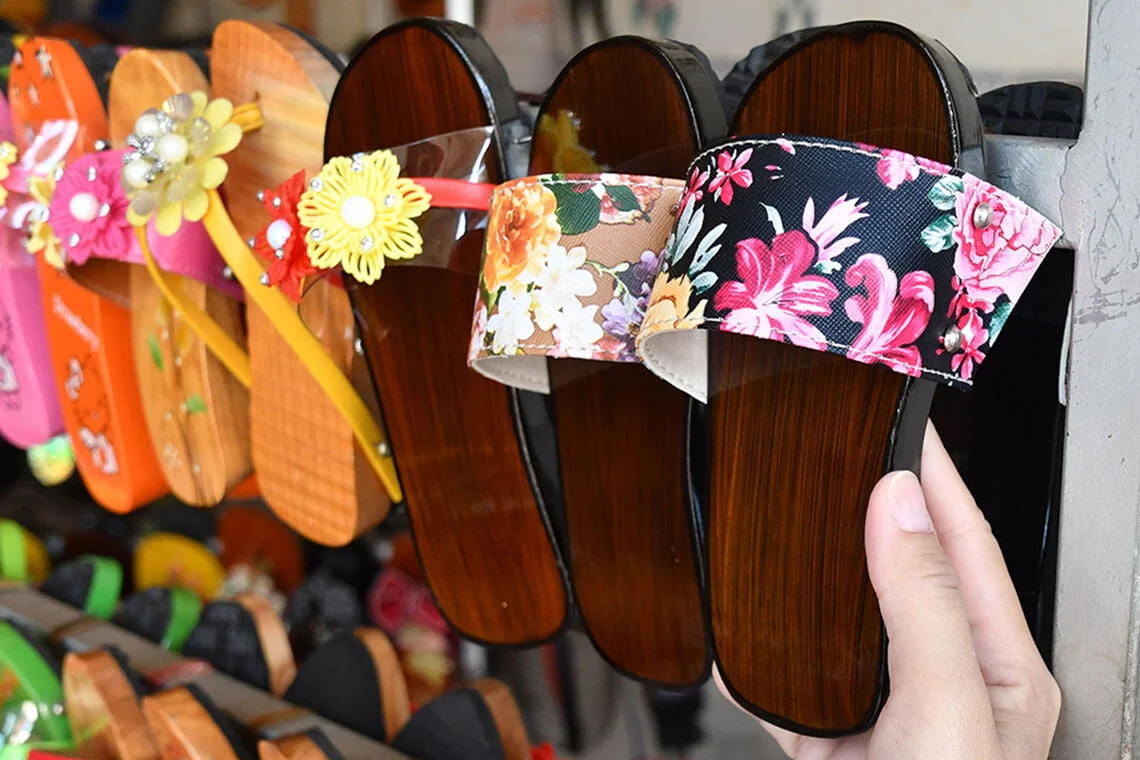
Wooden clogs have been a cornerstone of Vietnamese footwear for centuries, predating the áo dài by millennia. While no longer a daily staple, these handcrafted sandals remain a cherished souvenir and a testament to the nation’s resourcefulness and craftsmanship.
Historical Evolution
Early Origins:
The 3rd-century woman warrior Ba Trieu reportedly wore ivory clogs during her rebellion against Chinese invaders—a testament to their enduring cultural significance.
By the 19th and early 20th centuries, regional styles emerged:
- Guoc Ngu Nga: Ivory or bone-tipped clogs favored by Southern aristocrats, linked to rumors about health risks that later discredited them.
- Guoc Sai Gon: A single-strapped design introduced in Saigon (HCMC), later lacquered in black/brown to become Guoc Son (lacquered clogs).
Regional Variations:
- Phu Yen: Unpainted clogs with hourglass-shaped soles for women and straight “sampan clogs” for men.
- Hue: Painted in gold and white, reserved for the wealthy.
Decline and Revival:
- Pre-1945: Widely used with áo dài and áo tứ thân, crafted from coconut shells or light wood.
- 1970s: Replaced by plastic clogs, becoming rare outside of cultural preservation.
- Today: Survive as souvenirs (e.g., at HCMC’s Ben Thanh Market), often miniature or decorative, though made by authentic makers.
Why Buy Them?
- Cultural Symbolism: Rediscover styles linked to folk poetry and riddles (“Two females in dresses… left alone at home”).
- Durability: Crafted from vông wood or bamboo, these clogs are lightweight and weather-resistant.
>> Read More: What To Wear In Vietnam – A Comprehensive Packing Guide
Lacquerware items: A Legacy of Timeless Craft
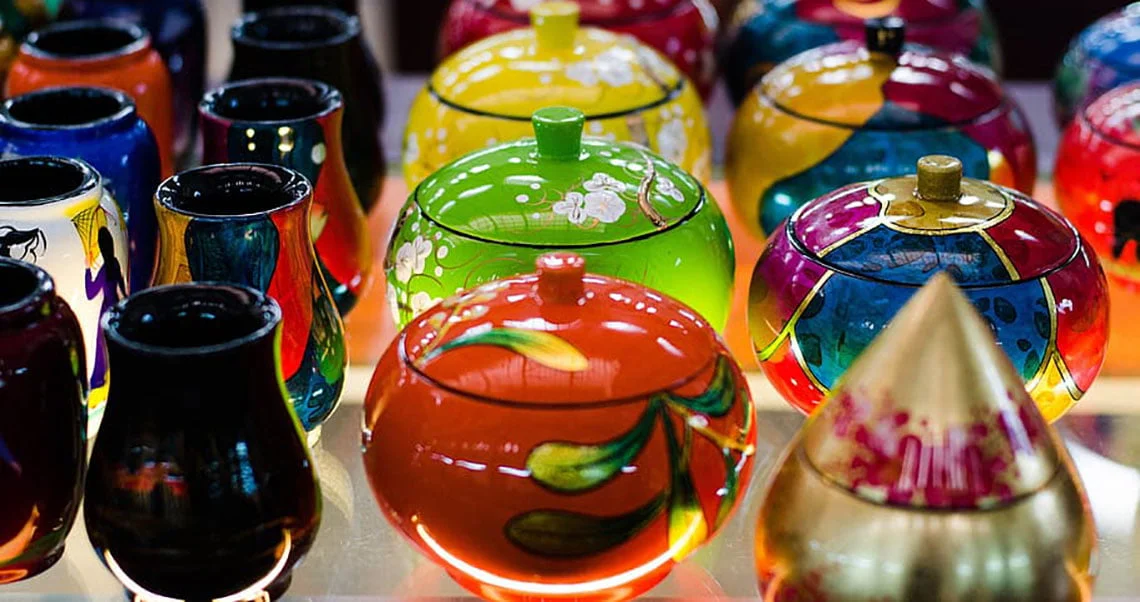
Vietnamese lacquer is a revered art form crafted through 20 meticulous stages, often taking 3–4 months to complete a single high-quality piece. This traditional technique transforms natural materials into decorative masterpieces and functional items, celebrated for their durability and aesthetic brilliance.
Production Process
Materials:
- Wood (rose, cherry, ebony, jackfruit) for furniture, jewelry boxes, or dishes.
- Assemblies (plywood, MDF) for modern designs.
Techniques:
- Coating: A natural resin (from Rhus succedanea trees) is mixed with mountain rock powder and applied in layers, followed by water-sanding to achieve smoothness.
- Decoration: Intricate eggshell inlays, mother-of-pearl, or hand-painted designs add visual depth.
- Phases: Each piece undergoes 10–20 layers of lacquer, with drying and polishing between stages.
Uses and Styles
- Decorative Items: Paintings, screens, or ornate picture books showcasing traditional motifs like dragons, peonies, or landscapes.
- Functional Pieces: Bowls, vases, trays, and jewelry boxes for daily use or gifts.
- Souvenir Value: Compact items (e.g., coasters, small boxes) are popular at shops like Ben Thanh Market for their portability and cultural significance.
>> Read More: Top 20 Fun Things to Do in Ho Chi Minh City
Why Choose Lacquerware?
- Durability: Resistant to insects and moisture due to the protective natural resin coating.
- Cultural Heritage: Preserved techniques passed down through generations, with artisans like Hanoia reviving traditional methods.
Food Souvenirs: Sweet, Sour, and Savored
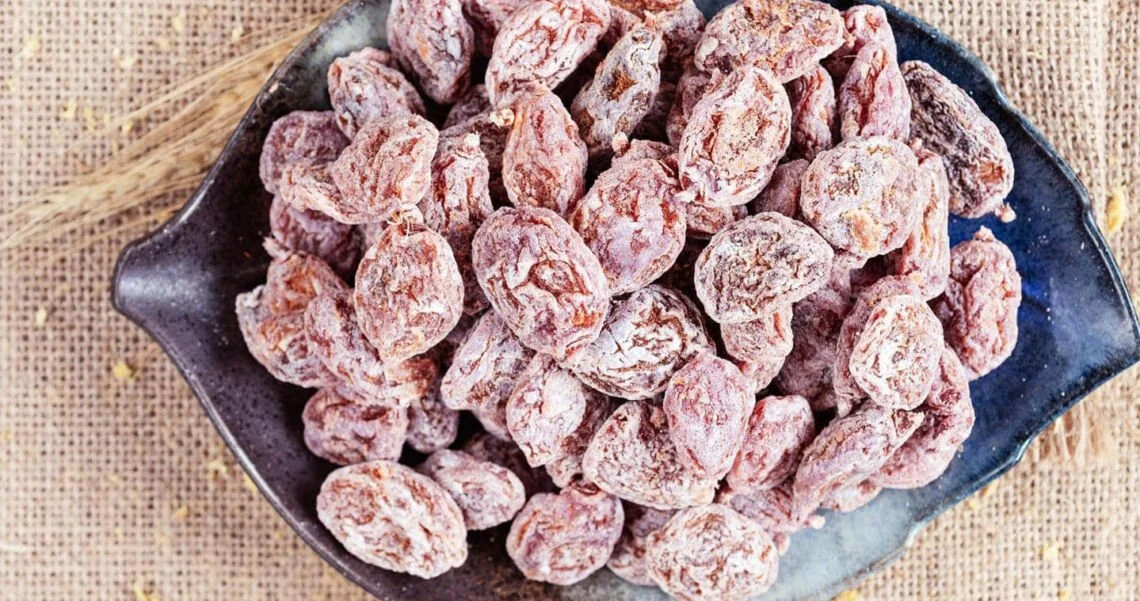
Vietnam’s food souvenirs are a delightful way to share the essence of its tropical cuisine and rich culture. From sugary treats to crispy snacks, these edible treasures are both budget-friendly and deeply rooted in regional traditions.
Popular Food Souvenirs
O Mai (Sugared Dry Fruits)
- Origin: A Hanoi delicacy, often prepared with salvaged fruits like tamarind, plums, or lotus seeds, glazed in sugar or honey.
- Taste: Ranges from sour (orange, ginger) to sweet (candied coconut).
- Price: Typically 50,000–200,000 VND ($2–$9) per box, depending on flavors.
Banh Dau Xanh (Mung Bean Pastry)
- Specialty: A Hai Duong Province staple, this smooth, green bean cake is often adorned with a golden dragon—a nod to its imperial past.
- Purpose: Ideal with tea or coffee, as the mung bean’s mild sweetness balances base bitterness.
Dried Fruits
- Variety: Includes jackfruit, banana, lychee, and mango, preserved through solar drying or oven-roasting.
- Use: A crunchy snack or topping for cereals/yogurt.
Keo Dua (Coconut Candy)
- Hometown: Ben Tre (Mekong Delta), famed for its chewy texture and pandan leaf or shortcake additions.
- Workshops: Visitors can attend hands-on sessions to craft their own candy.
Pricing & Buying Tips
- Budget Range: 20,000–150,000 VND ($0.90–$6.50) for most items, varying by packaging size.
- Top Venues:
- O Mai: Specialty shops in Hanoi’s Old Quarter.
- Keo Dua: Directly from Ben Tre markets or Ben Thanh Market (HCMC).
Hand-embroidered Products: Needlework Treasures of Vietnam
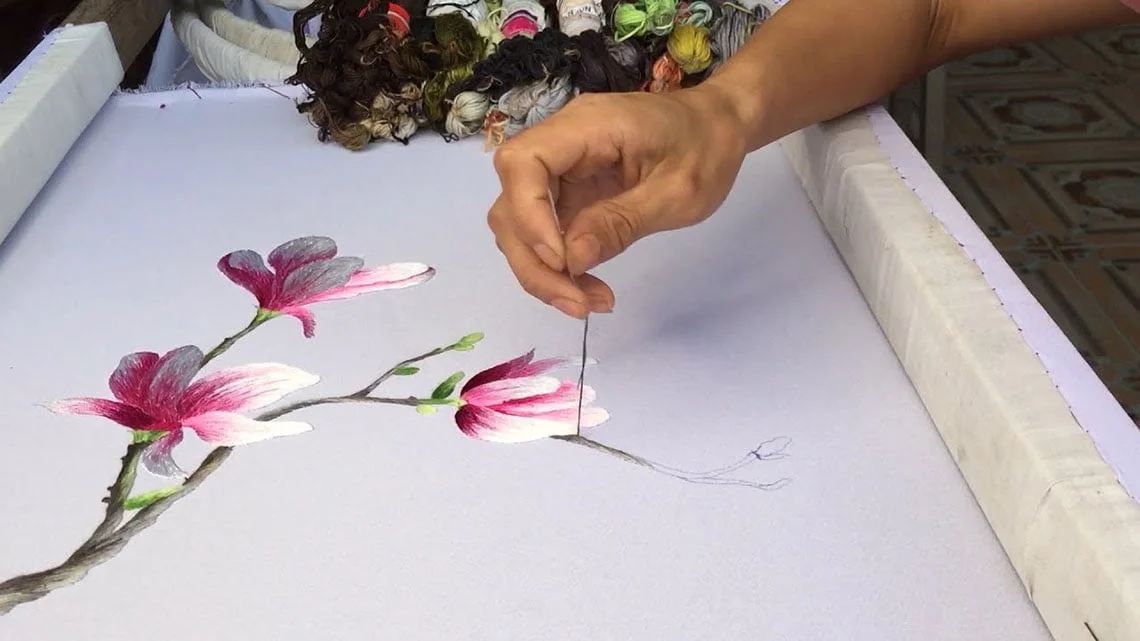
Hand-embroidered items rank among Vietnam’s most cherished souvenirs, blending traditional craftsmanship and contemporary design. These meticulously stitched creations range from elegant home decor (quilts, pillowcases, table runners) to portable accessories (scarves, bags, clothing).
Materials & Craftsmanship
- Fabrics: Most pieces use linen or cotton, with premium items crafted from silk for finer textures.
- Designs: Intricate patterns include natural motifs (blossoms, birds, landscapes) and cultural scenes (Hmong-inspired geometric patterns, Vietnamese festivals).
Production Hubs
- Hanoi: Specializes in large-scale artworks and customizable designs at shops near Hoan Kiem Lake.
- Sapa: Known for hill tribe-inspired embroidery, often seen in colorful scarves and authentic clothing.
Pricing & Sizing
- Small Items (scarves, pillowcases): 45,000–500,000 VND ($2–$22 USD).
- Large Artworks (bedspreads, framed designs): 2,000,000–10,000,000 VND ($85–$430 USD).
Note: Extremely high-end prices (e.g., $5,000) are uncommon; verify authenticity for costly items.
Customization
Shops in Hanoi and Sapa let you commission personalized designs (e.g., family portraits, names), often requiring weeks or months for completion.
>> See Tour: Hanoi – Sapa – Ninh Binh – Halong Bay Tour
Vietnamese Paintings: A Canvas of Culture and Tradition
Vietnamese paintings offer a captivating glimpse into the nation’s soul, blending artistic expression with cultural storytelling. From contemporary canvases to ancient folk art, these works span diverse media, themes, and price points, making them distinctive souvenirs.
Mediums and Styles
- Materials: Primarily oil, silk, and ink (search results confirm sand paintings are rare and not prominently featured).
- Subjects: Daily life, landscapes, historical narratives, and cultural symbols dominate.
Traditional Dong Ho Folk Paintings
Originating in Dong Ho Village (Bac Ninh Province), these works are cultural icons created through a meticulous process:
- Technique: Woodblock stamping on handmade dó paper, with each color applied layer by layer.
- Themes:
- Luck and prosperity (e.g., carp, roosters).
- Folktales (Thạch Sanh, the Frog Prince).
- Social commentary (satires of feudalism).
- Cultural Status: Designated a National Intangible Cultural Heritage in 2019.
Pricing and Authenticity
- Affordable Prints: Small reproductions start around 230,000 VND ($10 USD).
- Original Art:
- Mid-range: $50–$500 for silk or oil works.
- High-end: Auction records reach $3.1 million (e.g., Mai Trung Thu’s Portrait de Mademoiselle Phuong).
- Authenticity Tips:
- Seek certificates of origin for Dong Ho pieces.
- Vintage ink paintings (1960s–70s) are prized for historical value.
Where to Buy
- Galleries: Hanoi’s Old Quarter or HCMC’s Do Quang Em Gallery for contemporary oil/silk works.
- Villages: Dong Ho Village for authentic folk art.
- Online Platforms: Etsy and FineArtAmerica offer global access.
Paper Lanterns: Illuminating Tradition and Culture

Hoi An lanterns are not just decorative items; they are cherished symbols of happiness, good fortune, and cultural heritage in Vietnam. Crafted from bamboo frames and vibrant silk (or sometimes paper), these collapsible lanterns are both portable and emblematic of Vietnamese artistry.
Cultural Significance
- Historical Roots: Originating in the 16th–17th centuries, the lanterns evolved from practical lighting used by Chinese and Japanese merchants in Hoi An’s trading port to become a unique fusion of cultural influences.
- Symbolism: Beyond luck, they represent prosperity, community identity, and the preservation of ancient crafts.
Craftsmanship and Styles
- Materials: Artisans use saltwater-treated bamboo (to prevent termites) and Ha Dong silk for durability and luminosity.
- Variety: Available in diverse shapes (spherical, cylindrical, hexagonal) and colors, often featuring floral motifs or tribal patterns.
Where to Buy
Hoi An remains the epicenter of lantern production, with shops throughout the Ancient Town offering authentic pieces. Prices for small lanterns start around 90,000 VND ($4 USD), though intricate designs may cost more.
Postcards: Affordable and Nostalgic Vietnamese Souvenirs

Postcards remain a timeless and portable souvenir from Vietnam, widely available at souvenir shops, bookstores, and post offices nationwide. Prices for standard cards start at 20,000 VND ($0.85 USD), making them an accessible memento for travelers.
Key Details
- Iconic Purchase Spot:
- The historic Saigon Central Post Office (Ho Chi Minh City) is the most memorable venue to buy and mail postcards. Its French colonial architecture enhances the experience.
- Specialty Designs:
- Festival-themed cards: Brands like Zazzle offer designs celebrating Tet (Lunar New Year), such as “Snake New Year 2025” postcards ($1.15–$1.40 USD).
- Local art: Traditional paintings or scenic landscapes are common motifs.
- Budget Options:
- Multipacks: Sold at local shops (e.g., near the Saigon Post Office) for 20,000 VND per pack.
Why They Shine
- Cultural Snapshots: Capture daily life, festivals, or iconic landmarks like Hoi An lanterns or Halong Bay.
- Convenience: Ultra-lightweight and easy to mail globally.
>> See Tour: The Very Best of Vietnam
Tips to Shop in Vietnam: A Traveler’s Short Guide
Shopping in Vietnam blends vibrant markets with rich craftsmanship. To navigate this experience authentically and ethically, follow these verified strategies:
Bargain Strategically in Markets
- Where it’s expected: Street markets like Ben Thanh (HCMC) and Dong Xuan Market (Hanoi) have no fixed prices—vendors inflate costs by 50–100%. Start at 30–50% of the asking price and negotiate politely.
- Fixed-price zones: Look for labeled sections (e.g., Ben Thanh’s east exit) or malls like Takashimaya.
Optimize Payment Methods
- Cash: Essential for markets (small VND bills preferred).
- Cards: Accepted in malls and boutiques.
Verify Authenticity
- Textiles: Check for consistent stitching and natural fibers (silk, cotton).
- Lacquerware: Inspect for egg-shell inlays or mother-of-pearl—signs of handcrafting.
- Avoid mass-produced fakes: Prioritize shops linked to villages (e.g., Hanoia for lacquer).
Handle Logistics Smartly
- Fragile items (ceramics, paintings): Request protective wrapping or use shipping services.
- Liquids (fish sauce, coffee): Seal tightly and pack in checked luggage.
- Antiques: Confirm export permits to avoid customs issues.
Time Your Visits
- Mornings: Vendors are more open to deals.
- Avoid Tet (Lunar New Year): Crowds and inflated prices dominate.
Support Local Artisans
Buy directly from cooperatives (e.g., Sapa embroidery villages) or workshops (e.g., Hoi An lantern makers). This ensures fair wages and preserves traditions.
>> Read More: How To Plan A Trip To Vietnam
Bring An Authentic Piece of Vietnam Home With You
As you journey through vibrant cities, tranquil villages, and bustling markets, don’t miss the chance to collect Vietnam’s traditional products that are living symbols of the country. Not only will they serve as beautiful reminders of your trip, but they also support local artisans and preserve time-honored crafts.
Ready to explore Vietnam beyond the guidebooks? Let Asia Pioneer Travel create a tailor-made itinerary that takes you straight to the heart of authentic experiences—where you can meet the makers, visit craft villages, and shop like a local. Plan your cultural journey with us today!




